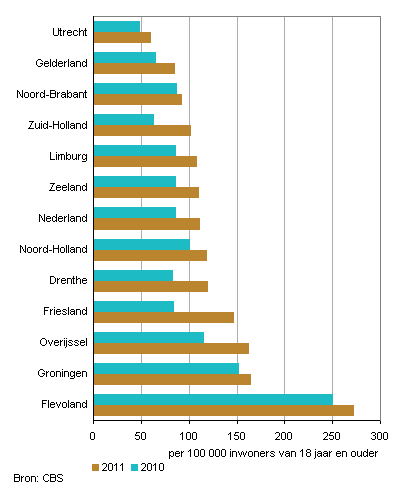Sustained increase restructured debts

Last year, 15 thousand court orders for debt repayment were pronounced, an increase by nearly 30 percent relative to 2010. The increase recorded since mid-2009 continues rapidly. After several years of decline, the number of restructured debts is back at the level of 2005-2007.
Increase mainly in category private persons
Altogether, nearly 15 thousand court orders for debt repayment were pronounced in 2011, i.e. 3.3 thousand more than in 2010. The increase mainly concerned private individuals, of whom some 12 thousand were engaged in debt restructuring schemes. Until the latter half of 2010, the increase mainly concerned (former) businesses, whereas over the past eighteen months, the increase is mainly found among private persons.
Court orders for debt repayment

Economic climate less favourable
The ongoing economic crisis causes a dramatic increase in the number of debt restructuring schemes. More businesses go bankrupt and unemployment is rising. Double mortgages and less lenient creditors account for a growing amount of restructured debts.
Considerable increase in Friesland and South Holland
Across the Netherlands, 112 in every 100 thousand residents aged 18 years and older were engaged in debt restructuring schemes in 2011. The amount increased in all provinces.
Although the amount of debt repayment schemes did not rise so rapidly in the province of Flevoland, the ratio per 100 residents was highest in this province (272). With 61 per 100 thousand residents, the lowest ratio was recorded in the province of Utrecht.
The amount of debt restructuring schemes increased most rapidly in the provinces of Friesland and South Holland in 2010 by 75 and 61 percent respectively.
Debt restructuring schemes by province

Marginal decline number of schemes for debt restructuring ending with clean slate
Nearly 11 thousand restructuring arrangements were concluded last year; 77 percent ended with a so-called clean slate, i.e. the remainder of the debtor’s outstanding debt is forgiven. The percentage of restructured debt schemes ending with a clean slate fell marginally in 2011 after many years of growth.
Debt repayment schemes by method of ending

Kees van den Berg and Mark Vlemmings